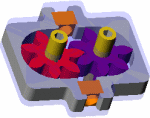 |
 |
| HYBRID ELECTRIC VEHICLES | ||
| QUESTIONS OR COMMENTS | ||
 |
AUTHOR: | Rosalind Takata |
| E-MAIL: | rktakatal@mit.edu | |
| COURSE: | 2A | |
| CLASS/YEAR: | 3 | |
MAIN FUNCTIONAL REQUIREMENT: Convert stored chemical power into mechanical power, to drive a vehicle, in a useful and environmentally sound way.
DESIGN PARAMETER:
Hybrid Electric Vehicle.
A system including batteries, electrical motors, a generator, and a second source of
torque with its fuel source. The second source of torque is often an internal combustion
engine, running on gasoline. In other cases, it may be an I.C.E. powered by hydrogen, a
diesel engine, a small gas turbine/generator, or a Stirling engine (the last two H.E.V.s
are still largely theoretical).
WHY A HYBRID CAR?
Everyone loves cars, they're convenient, they get you quickly from one place to another. Everyone hates pollution, it makes plants and animals and happy pristine environments unhappy. The H.E.V. is a compromise. Pure electric vehicles, while emission "free," can't go the distances or provide the power (for any extended length of time) of vehicles with internal combustion engines. Internal combustion engines pollute. H.E.V.'s combine both, so the vehicle can go as far and as long as most people would want and emit only a fraction of the harmful gases I.C.E.-powered vehicles do. The H.E.V. does this by balancing when and how each motor is used. On the highway, when internal combustion engines are at their most efficient, and where the battery would be depleted very quickly in an electric car, the I.C.E. is used. For shorter, city driving trips, the electric motor is either used exclusively, or in such a manner that the I.C.E. also runs, at its peak efficiency.
GEOMETRY/STRUCTURE:
Torque Sources: Internal combustion engine, relatively low power, about 20 hp. One, or, more likely, several electric motors
 |
Energy Storage: Battery (for electric motor) - usually a
common car battery, but varies from car to car. Other energy storers like flywheels and
"ultracapacitors" have not been as fully researched as batteries, but may be
seen in the future. Fuel cell - gasoline or diesel for the average commercial car, other research is being done on hydrogen and other potential fuel sources. |
 |
Energy Converter/"Collector": Generator - the
generator both converts electrical power from the battery to mechanical rotational and
converts rotation back into energy in order to charge the battery. The torque source can
be either the I.C.E. or the wheel shaft in regenerative breaking.(see below). Control: Transmission, various computerized and mechanical control systems. Control systems vary greatly from vehicle to vehicle. Like the one described below, they are all able to switch their drive mode from electrical to I.C.E., to a mode in which the two are working at once. |
On the highway, when internal combustion engines are at their most efficient, and where the battery would be depleted very quickly in an electric car, the I.C.E. is used. For shorter, city driving trips, the electric motor is either used exclusively, or in such a manner that the I.C.E. also runs, at its peak efficiency.
HOW IT ALL FITS TOGETHER:
There are two basic geometries to H.E.V. systems: parallel and series.
Parallel
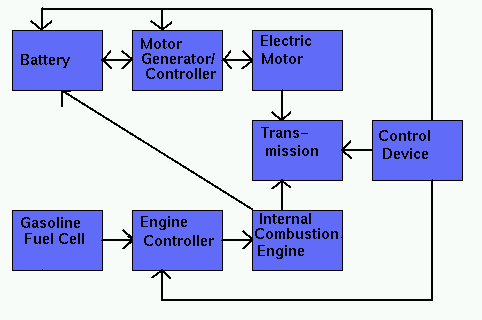 |
| Schematic of Parallel System |
Series
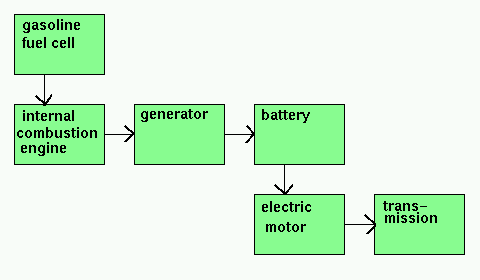 |
| Schematic of Series System |
THE DRIVE SYSTEM AND GETTING IT ALL TO FIT IN YOUR CAR: H.E.V. drive systems are very complex and vary greatly from vehicle to vehicle. The batteries are generally balanced - they are either centered or distributed between the front and rear of the vehicle, because they are heavy and take up a lot of volume. All other components are arranged for maximum efficiency and convenience (in many different configurations). The number of electric motors varies, as does the non-electric torque source. The presence of two power sources, makes a switching mechanism necessary. Most H.E.V. systems also allow both the I.C.E. (or other non-electric engine) and the electric motors to work simultaneously.
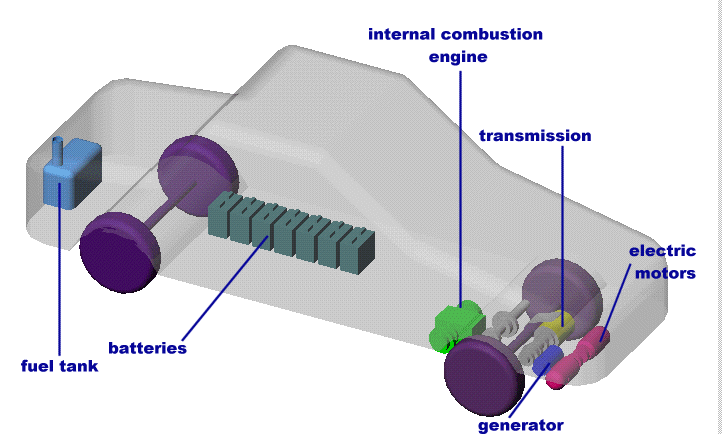 |
| Way Cool Transparent View of Possible H.E.V. System In Automobile |
This figure only shows one possible drive system - as in the choice of battery type, non-electric torque source, and almost everything else related to H.E.V.'s, the options are endless.
DOMINANT PHYSICS:
The flow of power through the hybrid system and the efficiencies and
mechanics of the components and connections therein comprise the most important physics in
the H.E.V. For the components used, the object of the H.E.V. designer is to connect and
control each part so that maximum efficiency is achieved.
An internal combustion engine runs most efficiently at highway speeds, and so it is used
alone in highway driving. It is very inefficient in stop and go traffic, however. An
electric motor would soon deplete its battery on a long highway drive, but can drive the
vehicle efficiently through city traffic with no emissions to release into the city
atmosphere. Of course, there are driving modes in between these, when both I.C.E. and
electric motors work in tandem, as when the vehicle is accelerating.
Power flow through the drive mechanism depends on the arrangement of the system and
several clutches which engage and disengage components from the assembly. In the following
diagrams (follow the links):
| solenoid clutch #1 | controls the connection between the I.C.E. and the generator. |
|---|---|
| solenoid clutch #2 | controls the connection between the I.C.E. and the transmission. |
| overrunning clutch #3 | controls the connection between the I.C.E. and the system. |
| overrunning clutches #4&5 | control the connections between the electric motors and the system. |
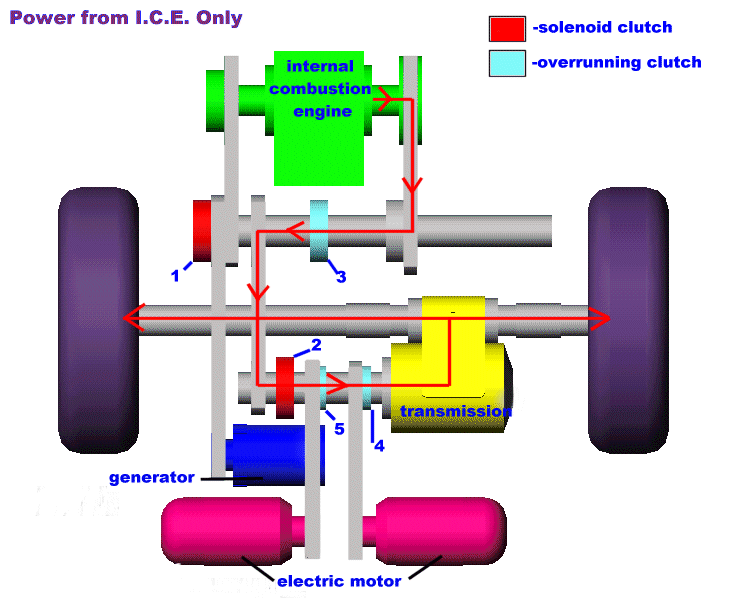
Power flows from the internal combustion engine, through the secondary drive shaft to the transmission. It then flows from the transmission to the primary drive shaft, and then to the wheels. Overrunning clutches 3 and 5 are engaged, all others are disengaged.
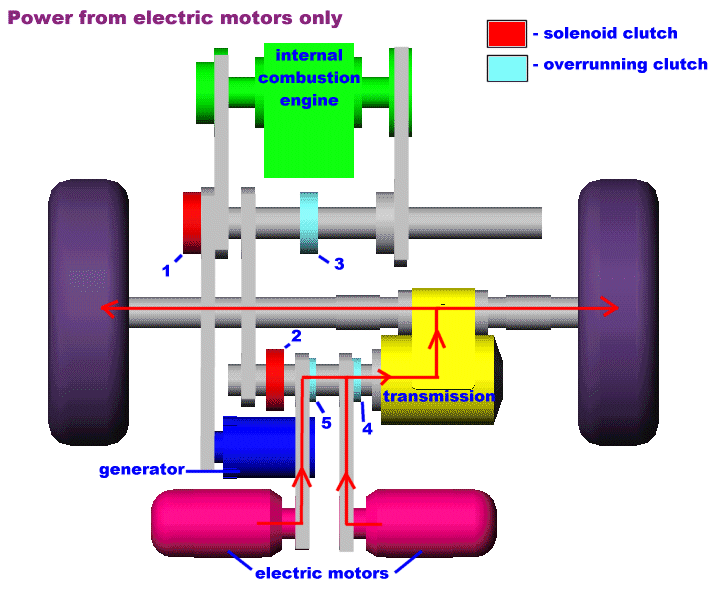
Power flows from both electric motors, through the transmission, and to the drive shaft and tires. Overrunning clutches 4 and 5 are engaged, all others are disengaged.
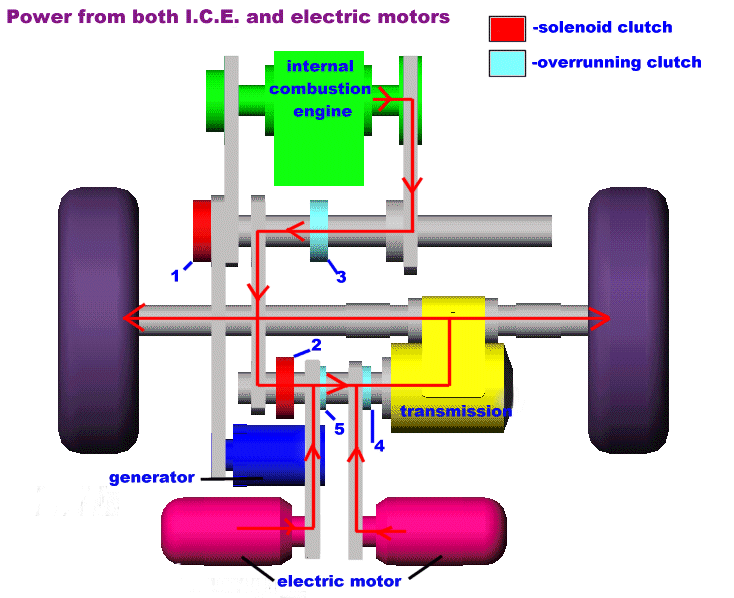
Power flows from the internal combustion engine, through the secondary drive shaft, through the transmission, and then to the primary drive shaft and then to the tires. Power also flows from both electric motors, to the transmission, and then to the primary drive shaft and the tires. Overrunning clutches 3, 4, and 5 are engaged and solenoid clutch 2 is engaged. All others are disengaged.
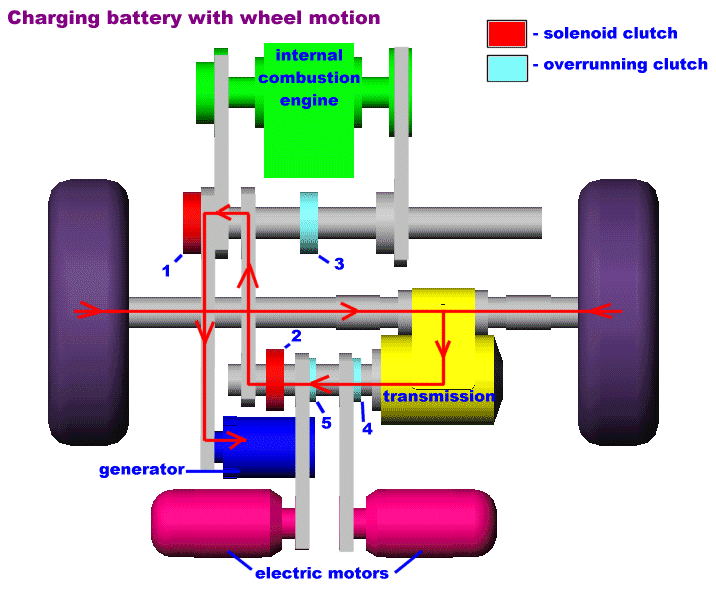
Power flows from the wheels to the primary drive shaft, then through the transmission, through the secondary drive shaft, and to the generator, and finally to the batteries. This occurs during regenerative braking. Solenoid clutches 1 and 2 are engaged, all other clutches are disengaged.
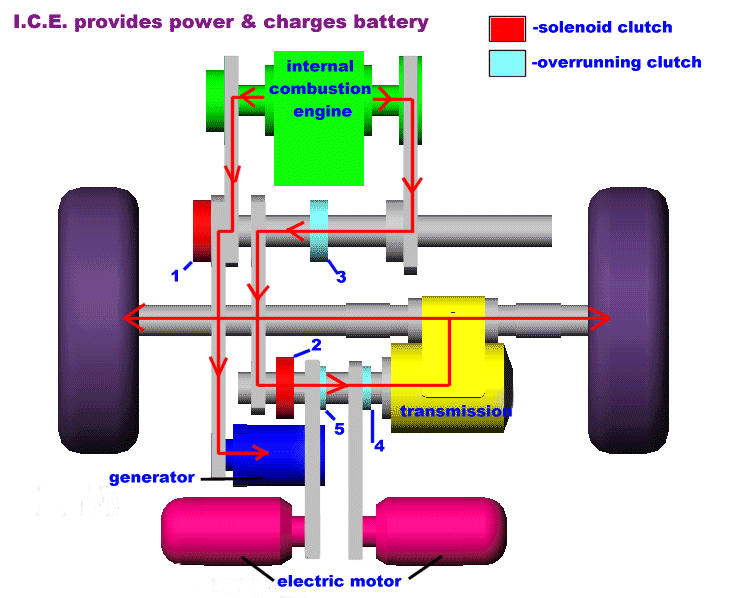
Power flows from the internal combustion engine, through drive shaft 2, to the transmission, and then to drive shaft 1 and the tires. Power also flows from the I.C.E., through drive shaft 2, and to the generator. Overrunning clutch 3 and solenoid clutch 1 are engaged, all others are disengaged.
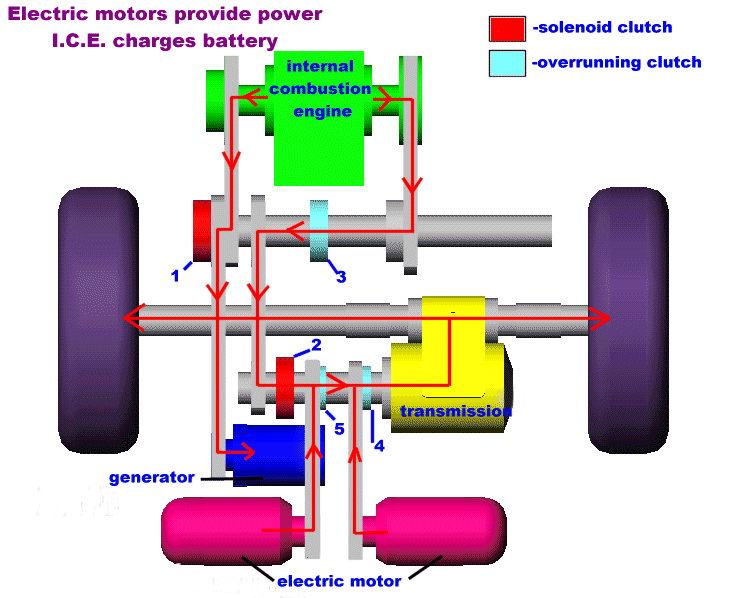
Power flows from the internal combustion engine, through the secondary drive shaft, to the transmission, then through the primary drive shaft and the tires. The I.C.E. also provides power to the generator, through solenoid clutch 1, and then to the batteries. Also, the electric motors provide power to the primary drive shaft, through the transmission. All clutches are engaged.
Many H.E.V.'s, and other non-hybrid vehicles, also use regenerative braking. This system takes some of the energy normally dissipated by friction when the car is braking and converts it back to useable energy.
If: T(t) = torque
W(t) = wheel speed (rotations/time)
P(t)=Power = T*W
The wheel shaft, rotating at speed=W and with torque=T, generates power P, all functions of time. Taking power from the wheels would slow the car down, which is normally undesirable except in braking. When the brakes are applied, the shaft of the generator is connected to the wheel shaft, so it can be rotated by the power of the wheels. The generator then converts this mechanical/rotational power to electrical power:
[CHECK MATHEMATICS!! OR WILL BE DELETED]
For a dc generator:
a = a(N,B,l,r) = a constant (for a particular generator)
V(t)=voltage
I(t)=current = a * T, and
P(electrical) = I * V = T * W = P(mechanical)
then: I = ( W / V ) * T, and
V = I / a * W
So the electrical power out is P = V * I = T * W assuming there are negligible frictional losses. This electrical power is then used to charge the vehicle's battery, conserving it for future use.
The H.E.V. also charges the battery with the I.C.E., through the same
process, when the vehicle is in motion. A controller monitors the state of the battery and
the speed of the I.C.E.. When battery charge is low and I.C.E. speed is high, it connects
the drive shaft of the engine to the generator, drawing power from the I.C.E. to charge
the battery. Because this controller is in place, the vehicle will not lose power when
accelerating, hill climbing, or otherwise in need of full power.
LIMITING PHYSICS:
The performance of an H.E.V. is limited by its efficiency and its capacity to carry its own fuel. Battery capacity and fuel energy density are both limits on the amount of power a vehicle can sustain.
The three major types of battery are lead acid (the most common car battery), NiCd (nickel-cadmium) and the newer NiMH (nickel-metal-hydride). Battery specific energy, specific power, cost, and life are the most important factors in choosing a battery.
| Specific energy (W-h/kg) |
Specific power (W/kg) |
Approximate cost ($/kWh) |
Approximate life (cycles to 80% discharged) |
|
|---|---|---|---|---|
| Lead-acid | 35 | 200 | 125 | 450 |
| NiCd | 40 | 175 | 600 | 1250 |
| NiMH | 70 | 150 | 540 | 1500 |
Units: specific energy or power is measured per unit of mass. This is important because any battery assembly will provide enough energy, provided there are enough batteries, but the H.E.V. has only limited volume and carrying capacity, so it needs to use batteries with high energy/power density.
W-h/kg = watt-hours/kilogram - the number of hours for which 1kg's worth of battery can provide a certain number of watts of power.
W/kg = watt/kg - the number of watts a 1kg battery can provide.
$/kW-h = dollars/kilo-watt-hour - the amount of money each hour of power costs, with power measured in thousands of watts.
Cycles to 80% DOD (depth of discharge) - the battery cycles through a chemical reaction (which depends on the type it is) in order to provide electrical power. This unit is the number of cycles each battery can provide before it is within 80% of discharge (a state in which there is not voltage drop across the battery, so it can provide no power). The numbers provided do not take re-charging into account.
PLOTS/GRAPHS/TABLES:
None Submitted
WHERE TO FIND HYBRID ELECTRIC VEHICLES:
Toyota, Ford, GM, Honda, Saturn...every major car company has already developed or is in the process of developing an H.E.V. Many other, smaller companies are also involved, as are private and public research agencies.
REFERENCES/MORE INFORMATION:
The Web Directory of Alternative Fuel & Advanced Vehicles
The Department of Energy/National Renewable Energy Lab's HEV page
Drive System: US Patent #5667029
General: U.S. Patent #05343970